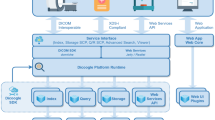Abstract
This paper highlights the differences among the most common file formats used for storing digital radiological images. It promotes the proper use of these formats to guarantee easy manipulation in handling the most typical practical applications in daily radiological practice. The authors provide a simple yet exhaustive introduction to the concept of “file format” and describe the algorithms and main features of the most common formats (BMP, JPEG, GIF, DICOM, TIF, PNG) and Portable Network Graphics (PNG).
The different formats are compared in terms of dimension, quality, portability and with reference to the following specific needs: electronic communications, publication on the World Wide Web, presentation of electronic posters, video presentations for teaching and manuscript publishing. We also illustrate how to handle the various formats with the programmes supplied with standard software installations.
The large number of digital applications of image file formats calls for a simplification in daily radiological practice. We recommend the use of JPEG and PNG for electronic communications; PNG and GIF for publication on the worldwide web; JPEG and PNG for electronic poster presentations; DICOM, PNG and JPEG for teaching presentations; TIF and PNG for printing on paper.
Riassunto
Evidenziare le differenze tra i più comuni formati di salvataggio delle immagini radiologiche digitali. Suggerire un uso appropriato e garantire la facilità di manipolazione nella gestione delle più tipiche applicazioni pratiche nel lavoro quotidiano in radiologia.
Vengono presentati in modo semplice ma esaustivo il concetto di “formato file”, gli algoritmi dei formati più comuni (BMP, JPEG, GIF, DICOM, TIF, PNG) e le loro caratteristiche principali.
Vengono messi a confronto i differenti formati in base a dimensioni, qualità, portabilità ed in relazione alle seguenti situazioni specifiche: comunicazione elettronica, pubblicazione su pagine internet, presentazione di poster elettronici, comunicazioni didattiche, stampa di pubblicazioni. Viene inoltre illustrato come gestire tali formati con i programmi che sono distribuiti assieme alle installazioni software standard.
Le numerose applicazioni digitali dei file immagine rendono d’obbligo una semplificazione nella pratica radiologica quotidiana. Troviamo consigliabile l’uso di file JPEG e PNG per le comunicazioni elettroniche; JPEG, PNG e GIF per pubblicazione a mezzo World Wide Web; JPEG e PNG per la presentazione di poster elettronici; DICOM, PNG, JPEG per scopi didattici; TIF e PNG per la stampa su carta.
Similar content being viewed by others
References/Bibliografia
Yang GL, Aziz A, Narayanaswami B et al (2005) Informatics in radiology (infoRAD): multimedia extension of medical imaging resource center teaching file. Radiographics 25:1699–1708
Graham RN, Perriss RW, Scarsbrook AF (2005) DICOM demystified: a review of digital file formats and their use in radiological practice. Clin Radiol 60:1133–1140
Kabachinski J (2007) TIFF, GIF, and PNG: get the picture? Biomed Instrum Technol 41:297–300
Wiggins RH 3rd, Davidson CH, Harnsberger HR et al (2001) Image file formats: past, present, and future. Radiographics 2:789–798
Gillespy T 3rd, Richardson ML, Rowberg AH (1994) Displaying radiologic images on personal computers: practical applications and uses. J Digit Imaging 7:101–106
Campioni P, Valentini V, Vincenzoni M et al (1996) Standardization of digital radiologic images. Rays 21:213–227
Baffoni L, Barone D; Gruppo di Studio PACS Italia (2004) PACS (Picture Archiving and Communication Systems). General principles and guidelines for its use. Radiol Med 107:1–72
Escott EJ, Rubinstein D (2003) Free DICOM image viewing and processing software for your desktop computer: what’s available and what it can do for you. Radiographics 23:1341–1357
Setti E, Musumeci R (2000) A visual displayer for publishing radiologic images on the World Wide Web. Radiol Med 99:383–387
Author information
Authors and Affiliations
Corresponding author
Rights and permissions
About this article
Cite this article
Faccioli, N., Perandini, S., Comai, A. et al. Proper use of common image file formats in handling radiological images. Radiol med 114, 484–495 (2009). https://doi.org/10.1007/s11547-009-0378-6
Received:
Accepted:
Published:
Issue Date:
DOI: https://doi.org/10.1007/s11547-009-0378-6




